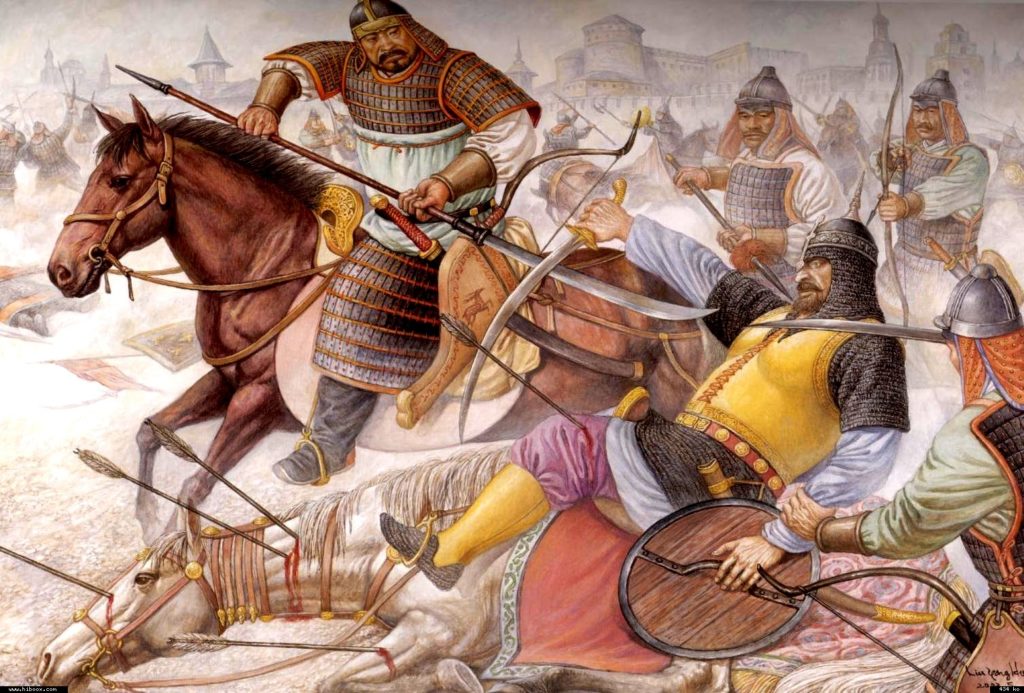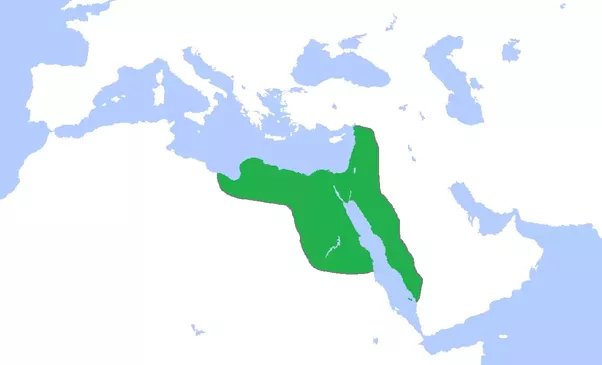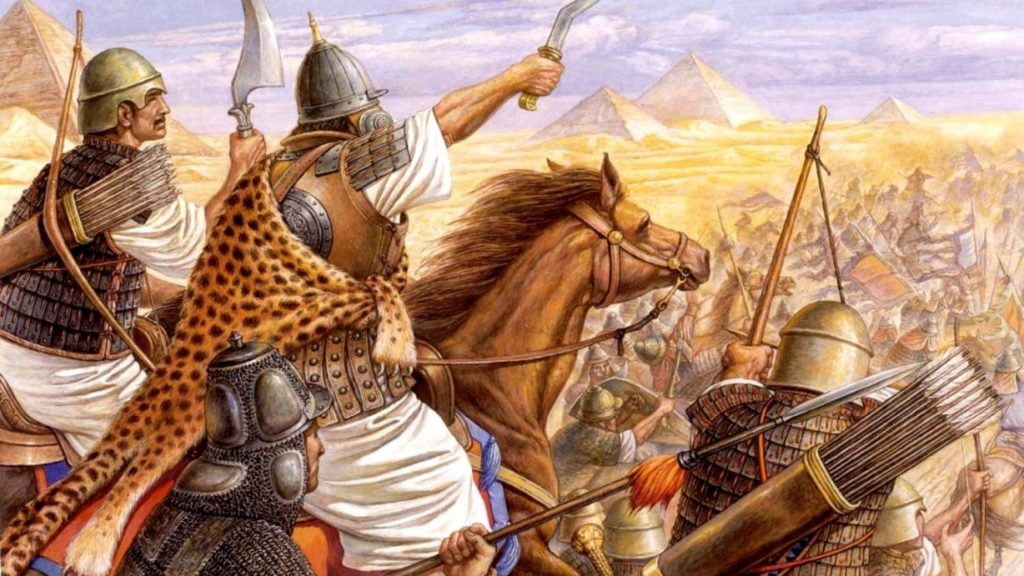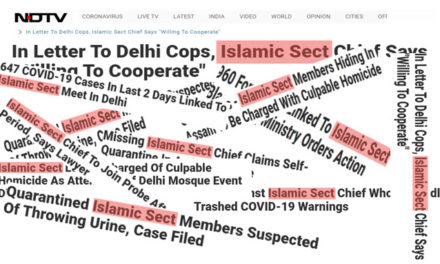In the 13th Century AD, the Tatars committed a great aggression against the Muslims on the Muslim lands, and as a result, the Caliph of the Muslims was killed, and three-fourths of the Muslim lands, including the capital Baghdad, came under the control of the Tatars. In these testing times, a great leader emerged. He was proud of his religion of Islam and that he was a servant of the Muslim people. He fought one of the decisive battles of his time and led the Muslim people when the Muslims had lost their centrality. This leader is “Fatih Sultan” Mahmud Saif al-Din Qutz and the battle he won is known as “Ain Jalut”. He was ably supported by his lieutenant Ruknuddin Baybars, who played a heroic role in implementing the war tactics of the Mongols on themselves.

Tatar aggression and occupation
Mongol-Tatars entered the Muslim lands at the end of 656 A.H. – When the Caliph of the Muslims, Abu Ahmad al-Mutashim Ballah, began to prepare his forces to stop the aggression, his minister “Al-alqami” tricked the Caliph into believing that peace with the aggressor was possible. And the preparation of the forces would make possible reconciliation impossible. Al-Qami began a secret correspondence with the Tatars and promised the Tatars that there would be no resistance in the event of an invasion if they assured of making Al-Qami the caliph if the invasion was successful. After that, When al-Alakami deceived the Muslims and succeeded in convincing them that a peace treaty was about to be concluded with the Tartars, al-Mu’tasim set out with his ministers and other leaders to meet the leader of the Tartars. The Tatars killed everyone and violated the honor of the Muslims in a very base manner
Traitor al-Alakami was declared a Traitor and killed by Tatars and failed to fulfil his dreams.
After the fall of Baghdad, Muslims had to face defeat after defeat. After occupying all of Iraq, the Tatars committed aggression on the land of Syria (Syria refers to the entire area of present-day Syria, Jordan, Palestine, Lebanon and some areas of Egypt and Iraq) and notched up the market of oppression and persecution as the people of these areas refused to surrender.
After the fall of Damascus, the Tatars moved towards Egypt and Morocco, which were the last strongholds of the Muslims on earth, and if they were occupied, then there would be no barrier in front of Mongols till they reached the Holy lands of Makkah and Medina.

Tatars Challenge to Mamluks
Traditionally, the Tatar commander “Katabagha” sent a threatening letter to the Amir of Egypt. It read something like this: “We have laid siege to the land, orphaned the children, punished and killed the people, destroyed the honour of their leaders. Do you think you can run away from us? After some time, you will know what is coming towards you.”
Despite the errors of language and speech in this letter, this letter had a deep impact on the Muslims.
Emir Qutz, who had been brought up in the Islamic way, responded contrary to the other ruler. He killed the delegation of Tatars and hung their bodies in his capital, which boosted the morale of his forces and people.
When Qutz’s reply arrived, the Tartars realized that in Egypt they were facing a different kind of King than they had encountered before.
Qutuz’s act drived inspiration from Muslim History and followed the example of Harun al-Rashid’s reply to the Roman chief “Nakfur” and “Al-Mu’tasim” to the governor “Amuria”.

Preparations for war
Qutz had an idea of what kind of reaction might follow such a clear answer. So he started preparations. He armed his people with psychological weapons like faith, unity before arming them with physical weapons. In order to achieve Unity, he sent Emir Baybars, his brave and popular deputy, to the scattered Muslim chieftains. Baybars was able to unite several emirs against the common enemy, The Tatars.
Baybars commissioned arsenals, battleships, and freight ships to aid his military endeavours. At the Battle of Ain Jalut, he may have also been the first person to use explosive hand cannons in combat (He was named Bunduqdari).
On the Other hand, Qutz was also well aware of the importance of Islamic scholars and was also aware of their influence among the people. He appealed to the Ulema for help. The most important scholar who helped the Sultan was “Sultan Ulama” Al-Azz bin Abdis Salam. Sultan Qutz asked Ibn Abdis Salam for a fatwa to levy more war taxes on the people so that more weapons could be obtained. The honest scholar made it clear to the Sultan that the government could not impose any new tax on the people until the governor and ministers spent all their personal wealth and all their relatives. Al-Azz also ordered the sale of these slave chiefs who were important officials of the government but were not legally freed from their owners and had gained power in the army.
The required amount was met without imposing any new taxes on the people. The people who were witnessing this whole process with their own eyes became loyal to the Mamluks government imposed by their rulers as told to them by the sincere Islamic scholars.
Practically the command of the forces was with Ruknuddin Baybars. After listening to the stories of the Tartars, Baybars used to say: “Let the time come, we will tell these barbarians that they are not the only ones who know how to fight, but there are also some people in the world who can snap their necks.”.
When Amir Rukn al-Din Baybars was informed of Halaku Khan’s return, he immediately suggested Sultan Qutz to attack the Mongols, who then asked him to advance. Ruknuddin Baybars marched immediately and engaged the Mongol armies.

The Battle
In keeping with the Prophet’s warning that “those who resist an attack in the middle of their land will be dishonoured,” Qutz ordered his forces to advance and attack the Compete. Qutz’s main forces, led by Qatzahi, advanced towards the coast of Palestine where the last strongholds of the Crusaders were located. Here Qutz threatened the Crusaders to remain neutral.
When the main Muslim forces approached the enemy forces, Qutz and Baybars chose the battlefield themselves, in a valley surrounded by mountains. The Mamluks stationed some soldiers on the mountains to provide defence in case the Crusaders were to make a treacherous attack, or if the Tartars and traitors attacked from behind.
According to many historical sources, The Mamluk Army’s General command was led by Ruknuddin Baybars who was later hailed as the main hero of the battle.
Tataris finally reached the battlefield, which was surrounded by three sides. The battle began and the balance seemed to tilt towards the Tatar forces. The right wing of the Tatar forces began to dominate the left wing of the Muslim forces. Muslim forces started retreating. In reality however, Rukn al-Din Baybars had used the Mongol against them. Baybars initially retreated and the Mongols fell into his trap. Entrapping the enemy by ambushing and trapping the enemy in a narrow place was the style of war of the Tatars, which was used by Rukn-ud-din Baybars that day, and Kutabgha Khan, who was intoxicated by the past victories, fell into the trick of Baybars. A safe Egyptian army ambushed the Mongols in the gorge. Disruption spread in the Mongol army and they were attacked by Muslims from two sides.
Despite this the Mongols kept pressing, to boost the morale of his forces Qutz climbed a rock and threw off his helmet and called out “Wa Islama wa Islama”, exhorting his forces to continue fighting and exhorting them not to retreat in battle from the enemies. The demoralised chiefs of the Muslim forces looked at their leader Qutz who was wielding his sword and madly penetrating between the ranks of the enemy. Qutz’s bravery stunned the leaders of the Muslim forces who immediately followed Qutz and the morale of the Muslim forces was restored. Within moments, the dice turned in favour of the Muslim forces.
Baybars massacred the Mongol army and beat them in a manner that had never been done to the Tatars before in history. Kutabgha Khan was captured by Baybars and killed. The Mongol army was completely killed or captured. The body of the slain Kutabgha Khan was exhibited in the streets of Cairo along with the Tatar prisoners and later these prisoners were also killed.
The news of the defeat of the Tatars in the field of Ain Jalut spread like wildfire in the Mongol conquests of Syria and Palestine. Spread out. The Muslims revolted against the Mongol rulers and news started coming from everywhere that the Muslims had begun to retake the city from the Tatars. In this way, most of the occupied territories of Syria and Palestine were freed from Mongol rule.

The impact of the war.
In this way, the black storm that arose from Mongolia draining the blood of the oppressed Muslims for forty years reached its end at the hands of Ruknuddin Baybars in the field of Ain Jalut. Even after that, the Tatars attacked the Muslim territories several times, but the impression of their invincibility was lost and now the Muslims were fighting them everywhere. The continuous Tatar attacks on India and the successful defense of the Khiljis is an example of it.
It was by the grace of Allah that in that opportune time, Egypt had leaders who rose from ground and were brave enough to take on the Mongols, he saved Egypt and Syria from the ravages of the Mongols. Otherwise, these countries would have suffered the same fate as Iran, Iraq and Turkestan. Egypt was The last important fortress on the Holy Land of Hejaz and just before the war with Egypt, the death of Monge Khan, The king of the Mongols the Subsequent Withdrawal of Hulagu khan and inability to return to the Islamic world because of the Mongol Civil war and Berke Khan reverting to Islam, is an indication that not only the Mamluks and Mongols but also the Divine Intervention had the biggest role in this battle. If it is said that instead of sending Ababil this time, Allah protected Haramain Sharifain and Bayt al-Maqdis etc. with his soldiers, then it would not be wrong.
The clash of the Mamluk and Mongol forces at Ain Jalut is one of the most important battles in world history—comparable to the battles of Marathon, Salams, Lapanto, Colonus, and Tugh—because it marked the Determination of future of Islamic and Western civilization. If the Mongols had succeeded in conquering Egypt, they would undoubtedly have advanced as far as the Straits of Gibraltar in East Africa after Halaku’s return. Thus, Europe would be surrounded by the Mongols from Poland to Spain. Under these circumstances, would the Renaissance have occurred in Europe? If it had, its foundations would undoubtedly have been much weaker and the world would probably be a much different place today.
The direct result of the war was the liberation of the Muslim people from the cruel Tatar invaders. As a result, the morale of the Muslims was restored and the correct teachings of Jihad spread among the Muslims and saved them from laziness, laziness and defeat. After this victory, the Muslims started hunting down the Tatars and started killing them whenever they were seen.
Click here to learn more





